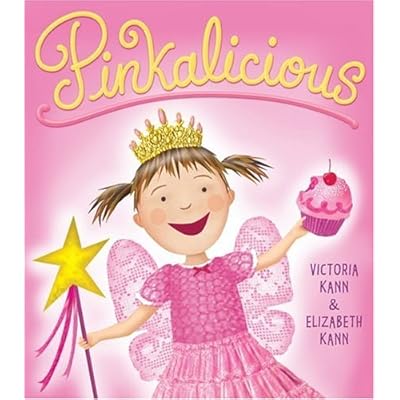




Title: Pinkalicious
Authors: Victoria Kann and Elizabeth Kann
Group: Amy Chan, Lilian Ng, Angelia Lui
Summary:
Pinkalicious loves the color pink. She wears pink, owns only pink things, and paints in pink all the time. The problem is, though, that black is the color that is considered “cool”, not pink, and all the other girls in her class tease her maliciously because of her love of everything pink. They also refuse to play with Pinkalicious because of this, leaving her to play alone after school. Pinkalicious becomes so upset by the teasing and the lack of friends that she goes home and cries, feeling like nobody understands her and that she is all alone in this world. She even decides to not like pink anymore, opting to wear blue instead and eating a plain vanilla ice cream, not her favorite Plum Pink Perfection ice cream. Then one day, Pinkalicious notices a girl in art class drawing a beautiful picture of a blue cake. Much to Pinkalicious’ surprise, the girl actually likes pink and even insists that it would be the perfect color to add to her picture. In the end, Pinkalici
ous has finally found someone who has accepted her for who she is, and they become friends.
Reflection:
At first sight, this book looks like a simple little children’s book, used for students no older than those in first grade. However, as we read the book a couple of times and looked through the pictures, there are a lot of hidden messages that can be discussed with third or even fourth graders. The simplicity of the text holds very sophisticated, in depth thoughts of peer pressure, feelings that children and people in general go through, being accepted/fitting in, and being yourself.
How the book can be used/curriculum units:
Activity 1: “The Power of Colors”
BEFORE introducing the book, have students brainstorm and/or freewrite about anything that comes up in their minds when they think of the color black. Then have them do the same with the color pink. AFTER reading the book, discuss: Why is black considered cool? Who decides on what the “cool” color is? As a project, students can take their favorite color and create a picture with only shades of that color. In writing, they will explain their picture. (the picture can be a reflection to the book)
Activity 2: “Fitting in, Being Accepted, and Being Who You Are”
This unit can start with discussing what peer pressure is. During this discussion, have students refer back to the book, and talk about how peer pressure affected Pinkalicious emotionally. How was Pinkalicious feeling when her favorite color was being made fun of? Although no one made fun of her when she was blue, how was she feeling then? Script writing and role plays can follow this discussion.
Activity 3: “Math with the Color Purple”
Using color dye, students can explore the different shades of purple using red, blue and white. They can record the number of drops of each color that it takes to make each shade of purple. Using the pattern they find, they will continue the number pattern using predictions. This activity can be an introduction to a lesson on skip counting, or multiplication.
Social Justice Curriculum:
1. Self-Love and Acceptance: Students will love themselves for who they are. They can relate to the text by thinking about the different situations that they have been in (examples: when they were teased, when they liked something that others did not) and look to Pinkalicious as a model that it is okay to be proud of who you are and what you like.
2. Respect for Others: Pinkalicious never ridiculed the others just because they wore black or were different. She was very proud of herself until they started to pick on her. The author addresses respect for others by showing that even though they specifically demonstrated to her that pink is not a cool color, Pinkalicious still respected what others favor, even when she does not like it herself.
3. Exploring issues of Social Justice: Students will tackle and learn more about acceptance, bullying, gender roles, and being an individual who is not afraid to be different rather than conforming to the norms of society or to what others believe are "the best."
4. Social Movements and Social Change: Students can explore the text and connect with personal experiences as well as the significant actions and emotions of significant figures. They can see the struggles that others went through in order to finally accept themselves and understand that they are not the only ones who struggle, but that they are the ones that need to take a stand for what they believe in.
5. Taking Social Action: Students will focus on their own classroom on how they can develop tools to work for change. As a first step, they will choose something that they truly believe in and love and may possibly be afraid to share with others (for example, a boy might say that he likes the color pink). They will make a booklet or a video about how this affects themselves and others by showing the importance of accepting oneself, despite what others say. If this is a great concern, anonymity may be used but there should be a section where the children are described individually by gender, maybe race, physical description, etc.
Correction: the book is called "Purplicious," but it's about a girl named Pinkalicious. Here's the link to buy the book: http://www.amazon.com/Purplicious-Elizabeth-Kann/dp/0061244058
ReplyDelete